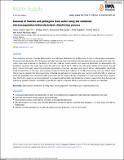| dc.description.abstract | The consecutive removal of fluoride (defluoridation) and pathogens (disinfection) in drinking water through combined electrocoagulation-inline-electrolytic disinfection (EC–ECl2) process with aluminum and dimension-stable mixed oxide electrodes was reported in this study. Laboratory trials were conducted on the effects of flow rate, initial pH, current density, and supporting electrolytes for defluoridation and disinfection processes. The results have shown that with a flow rate of 10 L/h, initial pH of 6, the current density of 9.4 mA/cm2 (EC cell) and 3.1 mA/cm2 (ECl2 cell), supporting electrolyte concentration of 165 mg/L, and electrolysis time of 50 min, a defluoridation rate of 88% (initial concentration of 12.3 mg/L) and complete disinfection (initial fecal coliforms of 19,700 colony-forming units per 100 mL (CFU/100 mL)) can be reached. The final concentration of fluoride and pathogens in treated water was 1.44 mg/L and 0 CFU/100 mL, which are within the acceptable limit of the World Health Organization and the Tanzania Bureau of Standards of 1.5 mg/L and 0 CFU/100 mL, respectively. The EC–ECl2 system is a promising approach for consecutive defluoridation and disinfection of water to save millions from fluorosis and waterborne diseases. However, optimization potential with regard to energetic efficiency and system complexity was identified. | en_US |

